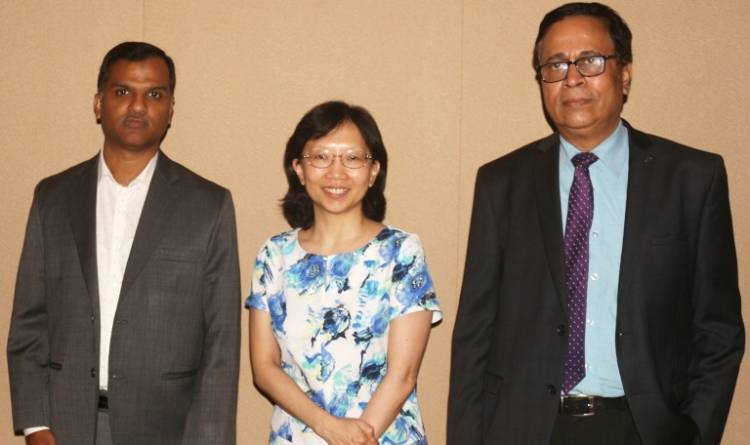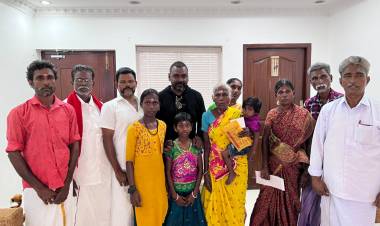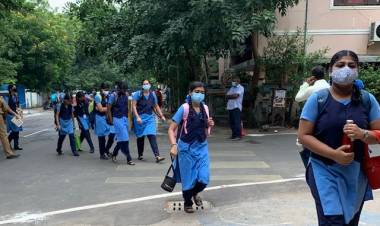Nutrition among toddlers in India

Photo Caption: (L-R) Dr. Irfan Shaikh, Head Pediatric Nutrition – Scientific & Medical Affairs, Abbott’s Nutrition business , Dr. Marion M. Aw, Associate Professor, Department of Pediatrics, National University Health System, Singapore, Dr Balasubramaniam Medical Director, Head of the Department of Pediatrics Coordinator, IAP ID Chapter PID Fellowship Program, Kanchi Kamakoti CHILDS Trust Hospital, Chennai.
Role of nutrition in addressing stunting and overweight problems in toddlers
‘Right Growth’ in toddlers is a prominent worry amongst today’s parents. They are constantly anxious whether their toddler is receiving the right nutrition. In fact, in today’s time this concern is valid as recent statistics from UNICEF/WHO/World Bank Group jointly highlight that the global burden of stunting in under-5 children is alarming. It is not just stunting that is worrying, but the fact that 38.3 million children globally, under the age of five are overweight.
According to Global Nutrition Report, India holds almost a third (31%) of the global burden for stunting. It is the country with the largest number of children who are stunted at 46.6 million, followed by Nigeria (13.9 million) and Pakistan (10.7 million). The urban prevalence of stunting on average is 19.2% compared with 26.8% in rural areas. India is also amongst the countries with more than a million children, who are overweight, as per Global Nutrition Report.
Dr. Marion M. Aw, Associate Professor, Department of Pediatrics, National University Health System, Singapore says “In 2018, 55% of all stunting cases in children under five years of age occurred in Asia. Two out of five stunted children in the world live in Southern Asia. Factors leading to poor development among children <5 years of age in developing countries include high rates of infection, deficient care, lack of stimulation and education, and instability at home. Poor nutrition has an adverse impact on child development, regardless of their severity.”
UNDERSTANDING A TODDLER’S GROWTH PATTERN
Childhood is the foundation year for growth. Number of diseases acquired during this period may carry over to adulthood or are risk factors for adult diseases. Hence right nutrition combined with ample physical activity is the key to a healthy and well-nourished child.
Children grow in natural, predictable steps, moving from one milestone to the next. Nutrition and physical activity are must for any child to have a right growth. Emotional and social development begins at age two - physical development, cognitive development, language, sensory and motor skills begin to refine.
Linear bone growth is the primary driver of whole body growth - is enabled by intake of sufficient and appropriate dietary protein and other key nutrients. These nutrients, in turn, stimulate the growth plate of long bones, and permit linked muscle growth and organ growth.
WHAT IS HIDDEN HUNGER?
Lack of micronutrients in a toddler’s diet can lead to hidden hunger – where the child is eating well, but the food being consumed is low on micro-nutrients. Deficiencies of some micronutrients, such as iron, magnesium and zinc, result in anorexia.
Also, several micronutrients, including zinc, iron and vitamin A, are associated with immune function which in turn affect growth. Children perceived as picky eaters had significantly lower intakes of certain micronutrients such as iron, zinc, vitamins A, B6, C, E, thiamine, riboflavin, and niacin compared to non-picky eaters.
ROLE OF NUTRITIION AND PHYSICAL ACTIVITY
Improved nutrition can lessen or even eliminate the negative impact of infections on growth. Good nutrition helps in strengthening the immune system, compensating for malabsorption, reallocation or losses of key nutrients, allowing for catch-up growth following infection, enhancing appetite and favoring the growth of beneficial gut microorganisms.
From a physical activity perspective, WHO recommends that children should accumulate at least 60 minutes of moderate- to vigorous-intensity physical activity daily. Amounts of physical activity greater than 60 minutes provide additional health benefits. In fact, a study reported that only 17% of Indian children aged 3–11 years met the WHO recommendations for physical activity levels (at least 60 min per day). Generally, children who engaged in physical activities consumed more fruits and vegetables.
Dr. Irfan Shaikh, Head Pediatric Nutrition – Scientific & Medical Affairs, Abbott’s Nutrition business said, “’Right Growth’ in toddlers is a combination of right nutrition and physical exercise. The age from two to six is the prime time for children to get the right amount of nutrients that lay the foundations to help them grow to their maximum potential. It is important for parents to understand that it is not just about solving picky eating behaviour – but it is more to do with how we are getting the essential nutrients including micro-nutrients to our toddlers. If corrective course is taken in early childhood, it will help in raising a healthy adult.”
WHAT CAN BE DONE
For right growth, children require a good mix of macro and micro nutrients that comes from five food groups in India –vegetables, fruits, protein, dairy and cereals. To ensure children eat right, following things could be tried, especially for pickyeaters
1. Create a food chain: Food-chaining is a long-term but effective technique to introduce your child to newer foods if he or she is highly selective (eats less than 15 foods and refuses entire groups of food). It builds on the previous step: making a list of foods that they typically consume and refuse. By looking for common characteristics in the food your child likes, such as flavour, texture or colour, you can begin introducing foods that are similar or prepared in a similar manner.
2. Anchor Foods: As the name suggests, these are foods that anchor the diet and provide basic nutrients for children who are growing normally but have a limited variety. If a child eats one of each of these foods, then a parent can be reassured that they are getting adequate nutrition. A growing child’s wholesome diet should ideally include all the five food groups – dairy for calcium, fruits for vitamins, cereals for carbohydrates, meats and nuts for proteins, and vegetables for minerals.
3. Nutritional supplements: The stress of meeting the child’s nutritional requirements can also be mitigated by getting toddlers started on a child nutrition supplement which has all the essential nutrients for the wholesome growth and development of a child. It is advisable to consult a doctor for an informed view on what is best for the toddler and additional measures that can ensure the child receives essential nutrients.
4. Physical Activity: Most of the daily physical activity should be aerobic. Vigorous-intensity activities should be incorporated, including those that strengthen muscle and bone, at least 3 times per week. For children and young people, physical activity includes play, games, sports, transportation, recreation, physical education, or planned exercise, in the context of family, school and community activities.
“Nutrition and physical activity are key to achieving right growth for a child. Micronutrients too are essential for proper growth and development. However, today with eating habits changing, it is being seen that children are not getting the right nutrition thereby impacting their growth. Wholesome foods such as fruits and vegetables are no longer part of a child’s diet.
The other key factor is that despite, Chennai being a sunny place there is deficiency of Vitamin D in children because they are not exposed to it adequately. In fact, it is seen that iron deficiency amongst children in Chennai is on the rise. According to the National Family Health Survey, the prevalence of Anemia is at 58.6 % in India amongst children below the age of 5. Anemia can lead to hyperactivity in children and can affect intellectual development” says Dr Balasubramaniam Medical Director, Head of the Department of Pediatrics Coordinator, IAP ID Chapter PID Fellowship Program, Kanchi Kamakoti CHILDS Trust Hospital, Chennai.




















